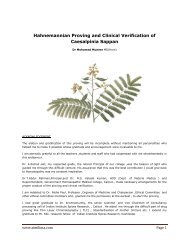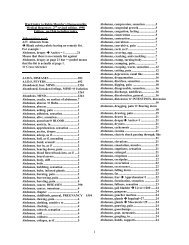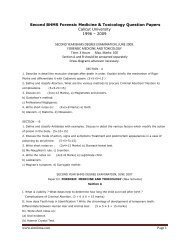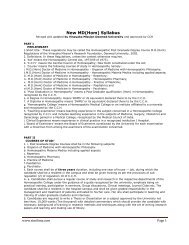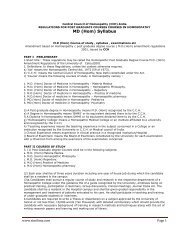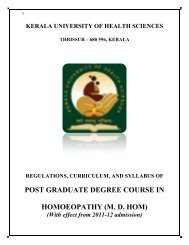Denotations & Old terminologies used in Homopathy - Similima
Denotations & Old terminologies used in Homopathy - Similima
Denotations & Old terminologies used in Homopathy - Similima
Create successful ePaper yourself
Turn your PDF publications into a flip-book with our unique Google optimized e-Paper software.
Dischromotopsia Dyschromatopsia, achromatopsia, color vision deficiency an <strong>in</strong>dividual with<br />
achromatopsia cannot tell the difference between colors. Some people with<br />
achromatopsia can only see shades of gray. A person with this condition usually<br />
has poor distance vision, light sensitivity, and rapid eye movement.<br />
Dyschromatopsia is the more common form of color bl<strong>in</strong>dness. Individuals with<br />
this condition usually have excellent vision. The person usually cannot tell the<br />
difference between shades of red and green. In rare cases, the person cannot<br />
tell the difference between shades of blue and yellow. Most hypotheses of<br />
acquired dyschromatopsia <strong>in</strong>voke the mechanism of selective damage to specific<br />
components of the afferent visual system toexpla<strong>in</strong> the predom<strong>in</strong>ance of redgreen<br />
and blue-yellow hue- discrim<strong>in</strong>ation defects found <strong>in</strong> neural and ret<strong>in</strong>al<br />
disorders, respectively. However, this pattern of hue-discrim<strong>in</strong>ation disturbance<br />
<strong>in</strong> ocular disease may vary. There are frequent exceptions which are<br />
<strong>in</strong>adequately expla<strong>in</strong>ed by exist<strong>in</strong>g hypotheses. In an effort to expla<strong>in</strong> the<br />
pattern and pathogenesis of acquired dyschromatopsias better, the authors<br />
exam<strong>in</strong>ed patients withnonproliferative diabetic ret<strong>in</strong>opathy (dr) and late-stage<br />
retrobulbar neuritis (rbn) us<strong>in</strong>g age-corrected farnsworth-munsell 100-hue<br />
test<strong>in</strong>g and threshold static perimetry. As expected, most dr eyes showed some<br />
degree of relative blue-yellow dyschromatopsia (89%) with few show<strong>in</strong>g a<br />
greater weight<strong>in</strong>g towards red- green dyschromatopsia (11%). However,<br />
an approximately equal number of rbn eyes had a relative blue-yellow<br />
(48%)versus red-green dyschromatopsia (52%). For rbn, the authors found a<br />
strong association between the spatial distribution of field defect and the type of<br />
relative hue-discrim<strong>in</strong>ation disturbance. Eyes with greater field depression at the<br />
fovea relative to the per fovea showed a relative preponderance of red-green<br />
dyschromatopsia (68%) as opposed to blue- yellow dyschromatopsia (32%),<br />
whereas eyes with greater relative perifoveal impairment showed a relative<br />
preponderance of blue-yellow dyschromatopsia (100%). This relationship<br />
between the relative spatial distribution of visual field damage and the relative<br />
hue-discrim<strong>in</strong>ation deficit <strong>in</strong> rbn was statistically significant (p = 0.002). Such an<br />
association was not found for dr.(abstract truncated at 250 words)<br />
Dissem<strong>in</strong>ated<br />
sclerosis<br />
Multiple sclerosis.<br />
Diuresis Increased excretion of ur<strong>in</strong>e <strong>in</strong> amount.<br />
Diurnal enuresis Involuntary discharge of ur<strong>in</strong>e, usually referr<strong>in</strong>g to <strong>in</strong>voluntary discharge of<br />
ur<strong>in</strong>e <strong>in</strong> sleep dur<strong>in</strong>g night.<br />
Dumb ague Dumb chill.a subacute form of malaria with irregular attacks of fever without<br />
chill.a form of <strong>in</strong>termittent fever which has no def<strong>in</strong>ite chill stage.<br />
Dyscrasia An abnormal morbid or sick state of the body.<br />
Dysparunia Pa<strong>in</strong>ful or difficult <strong>in</strong>tercourse.<br />
Dysphagia Difficulty <strong>in</strong> swallow<strong>in</strong>g.<br />
Ebullitions Effervescence.a boil<strong>in</strong>g or bubbl<strong>in</strong>g up, such as when blood rushes to the face or<br />
hot flashes.<br />
Ecchymosis Briuse, black and blue spot.a purplish patch ca<strong>used</strong> by extravasation of blood<br />
<strong>in</strong>to the sk<strong>in</strong>.<br />
www.similima.com Page 14




